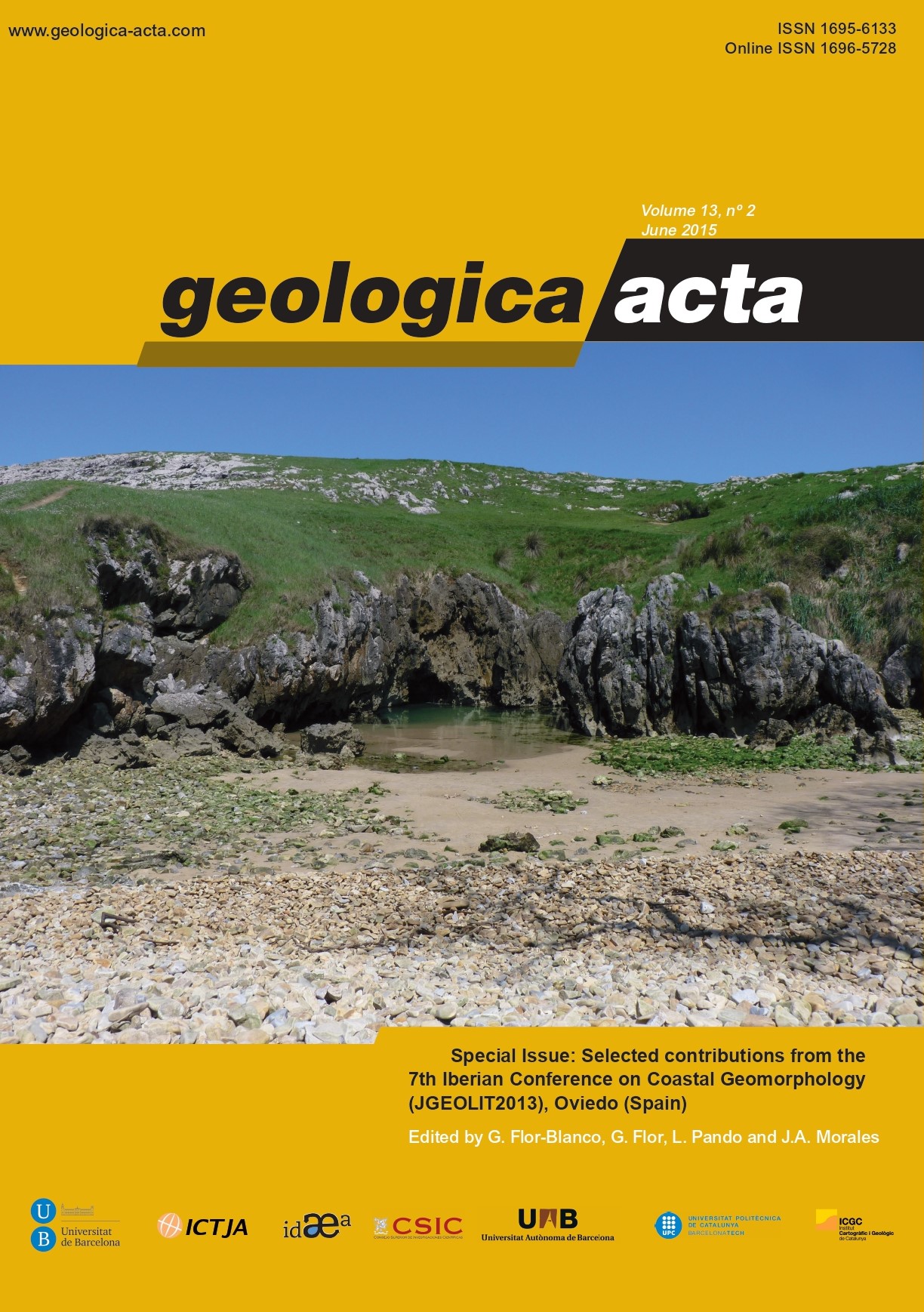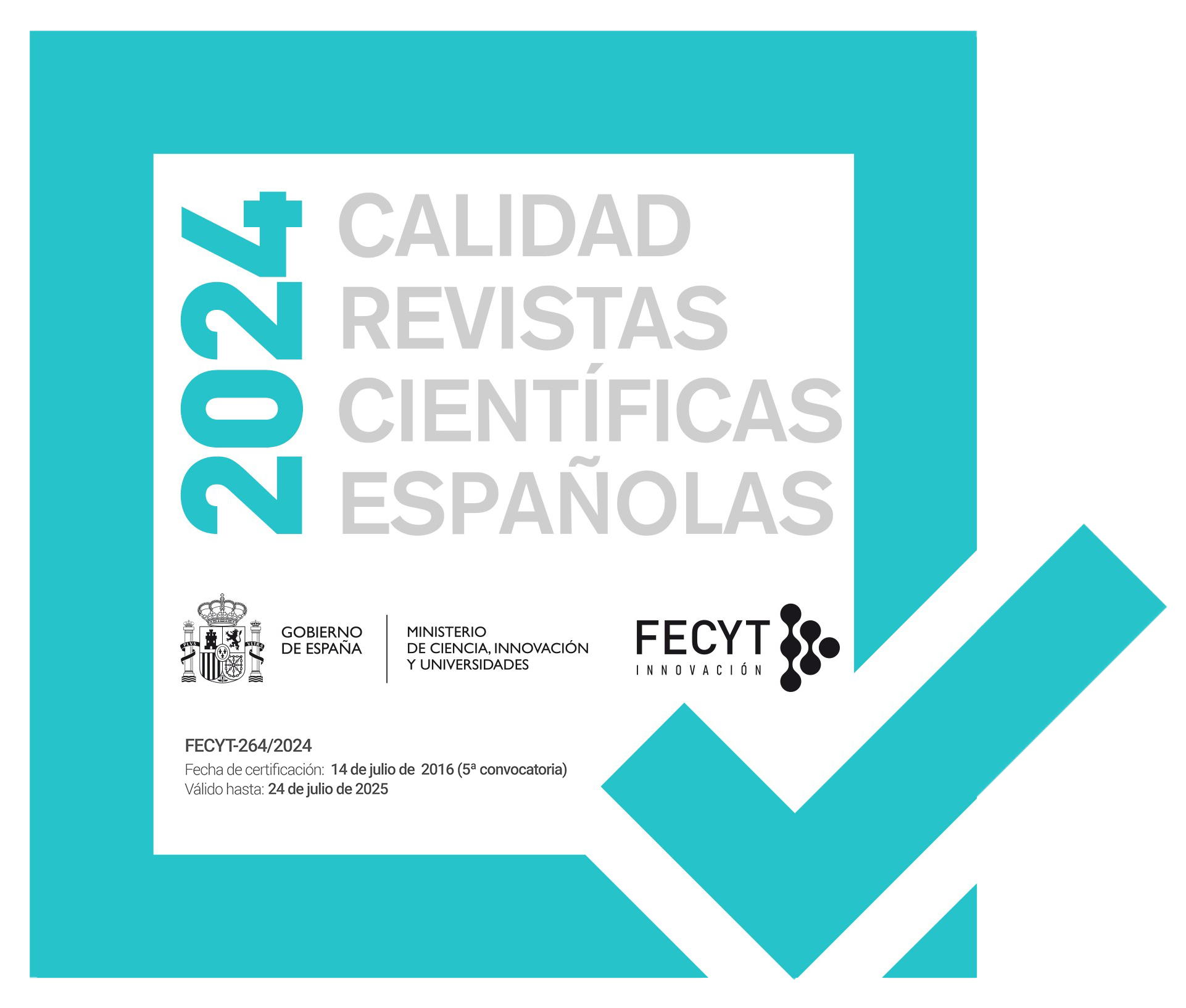Recent evolution of the river mouth intertidal zone at the Río San Pedro tidal channel (Cádiz Bay, SW Spain): controlling factors of geomorphologic and depositional changes
DOI:
https://doi.org/10.1344/GeologicaActa2015.13.2.4Keywords:
Cádiz Bay, Coastal environments, Saltmarsh, Recent evolution, Morphological changesAbstract
Sedimentary and photogrammetric analysis of a sector of Cádiz Bay (SW Spain), including the intertidal zone on the left bank of the Río San Pedro tidal channel, were performed to understand its environmental evolution and the main factors that controled it. The study of this especially vulnerable environment has allowed to establish its depositional and morphological responses to the dynamic processes caused by recent environmental or climate changes. In the bank of the Río San Pedro tidal channel, there is a well-developed saltmarsh, which alternates with sandy beaches the data indicate erosional processes. The saltmarsh retreat rate was estimated in 0.65m/yr from 1977 to 2008. In this time-period, the tidal channel experienced a lateral displacement toward the SE of 1.24m/yr, and the beach width decreased from 50 to 21m. Three evolutionary stages were established: a youth stage, represented by a relatively high water energy beach environments; a maturity stage: represented by saltmarsh with deposition of mud and halophyte vegetation; a reactivation stage: represented by erosive features in the saltmarsh, such as tidal pools, tidal channel, etc. The geological location of Cádiz, close to the Eurasian–African plate boundary, account for its relatively high seismic and tsunami activity, that caused significant depositional changes in the area. Others important factors controlling the sedimentation are: first the tides, followed by the waves and the proximity to a sand source, such as the sandy mantle of La Algaida.References
Alonso, A., Pagés, J.L., 2010. Evolución del nivel del mar durante el Holoceno en el Noroeste de la Península Ibérica. Revista de la Sociedad Geológica de España, 23 (2-3), 157-167.
Álvarez, O., Tejedor, B., Tejedora, L., Kaganc, B.A., 2003. A note on sea-breeze-induced seasonal variability in the K1 tidal constants in Cádiz Bay, Spain. Estuarine, Coastal and Shelf Science, 58, 805-812.
Andrade, C., 1991. Tsunami generated forms in the Algarve barrier island (South Portugal). Science of Tsunami Hazards, 10, 21-34.
Andrade, C., Freitas, M.C., Moreno, J., Craveiro, S.C., 2004. Stratigraphical evidence of late Holocene barrier breaching and extreme storms in lagoonal sediments of Ria Formosa, Algarve, Portugal. Marine Geology, 210, 339-362.
Borja, F., Zazo, C., Dabrio, C.J., Díaz del Olmo, F., Goy, J.L., Lario, J., 1999. Holocene aeolian phases and human settlements along the Atlantic coast of southern Spain. Holocene, 9(3), 333-339.
Campos, M.L., 1991. Tsunami hazard on the spanish coasts of the Iberian Peninsula. Science of Tsunami Hazard, 9(1), 83-90.
Dabrio, C.J., Goy, J.L., Zazo, C., 1998. The record of the tsunami produced by the 1755 Lisbon earthquake in Valdelagrana spot (Gulf of Cádiz, sothern Spain). Geogaceta, 23, 31-34.
Dabrio, C.J., Zazo, C., Goy, J.L., Sierro, F.J., Borja, F., Lario, J., González, J.A., Flores, J.A., 2000. Depositional history of estuarine infill during the last postglacial transgression (Gulf of Cádiz, southern Spain). Marine Geology, 162, 381-404.
Davis, R.A. Jr., Dalrymple, R.W., 2012. Principles of tidal sedimentology. Springer, 404pp.
Galbis, R.J., 1932. Catálogo sísmico de la zona comprendida entre los meridianos 5ºE y 20ºW de Greenwich y los paralelos 45° y 25°N. Dirección General del Instituto Geográfico y Catastral, Madrid, 807pp.
Galbis, R.J., 1940. Catálogo sísmico de la zona comprendida entre los meridianos 5°E y 20°W de Greenwich y los paralelos 45° y 25°N. Dirección General del Instituto Geográfico y Catastral, Madrid, 277pp.
Grimison, N.L., Chen, W.P., 1986. The Azores-Gibraltar Plate Boundary: focal mechanisms, depths of earthquakes, and their tectonic implications. Journal of Geophysical Research, 91, 2029-2047.
Gutiérrez-Mas, J.M., 2011. Glycymeris shell accumulations as indicators of recent sea-level changes and high-energy events
in Cádiz Bay (SW Spain). Estuarine, Coastal and Shelf Science, 92, 546-554.
Gutiérrez-Mas, J.M., Achab, M., Gracia, F.J., 2004. Structural and physiographic control on the Holocene marine sedimentation in the Bay of Cádiz (SW Spain). Geodinamica Acta, 17(2), 47-55.
Gutiérrez-Mas, J.M., Juan, C., Morales, J.A., 2009a. Evidence of high-energy events in shelly layers interbedded in coastal Holocene sands in Cádiz Bay (south-west Spain). Earth Surface Processes and Landforms, 34, 810-823.
Gutiérrez-Mas, J.M., López Arroyo, J., Morales, J.A., 2009b. Recent marine lithofacies in Cádiz Bay (SW Spain). Sequences, processes and control factors. Sedimentary Geology, 218, 31-47.
Kolker, A.S., Steven, L., Goodbred, S.L. Jr., Hameed, S., Kirk Cochran, J., 2010. High-resolution records of the response of coastal wetland systems to long-term and short-term sea-level variability. Estuarine, Coastal and Shelf Science, 84, 493-508.
Lario, J., Zazo, C., Goy, J.L., Dabrio, C.J., Borja, F., Silva, P.G., Sierro, F., González, A., Soler, V., Yll, E., 2002a. Changes in sedimentation trends in SW Iberia Holocene estuaries (Spain). Quaternary International, 93-94, 171-176.
Lario, J., Spencer, C., Plater, A.J., Zazo, C., Goy, J.L., Dabrio, C.J., 2002b. Particle size characterization of Holocene backbarrier sequences from North Atlantic coast (SW Spain and England). Geomorphology, 42, 25-42.
Long, A., 2000. Late Holocene sea-level change and climate. Progress in Physical Geography, 24(3), 415-423.
Luque, L., Lario, J., Civis, P.G., Zazo, C., Goy, J.L., Dabrio, J.C., Silva, P.G., 2002a. Tsunami deposits as paleosismic indicators: examples from the Spanish coast. Acta Geologica Hispanica, 36(3-4), 197-211.
Luque, L., Lario, J., Civis, J., Silva, P.G., Zazo, C, Goy, J.L., Dabrio C.J., 2002b. Sedimentary record of a tsunami during Roman times, Bay of Cádiz, Spain. Journal of Quaternary Science, 17(5-6), 623-631.
Monge, A., Matos, J.M., 2009a. Radiocarbon dating of marine shell samples. The marine radiocarbon reservoir effect of coastal waters off Atlantic Iberia during Late Neolithic and Chalcolithic periods. Journal of Archaeological Science, 36, 2875-2881.
Monge, A., Matos, J.M., 2009b. Radiocarbon dating of marine samples from Gulf of Cádiz: The reservoir effect. Quaternary International, 221(1-2), 9-12.
Morales, J.A., Borrego, J., San Miguel, E.G., López-González, N., Carro, B., 2008. Sedimentary record of recent tsunamis in the Huelva Estuary (southwestern Spain). Quaternary Science Reviews, 27(7-8), 734-746.
REDIAM (Red Información Ambiental de Andalucía, Junta de Andalucía), 2012. Ortofotografía Digital. Hoja 1061-4-4.
http://www.juntadeandalucia.es/medioambiente/site/rediam
Reimer, P.J., Baillie, M.G.L, Bard, E, Bayliss, A., Beck, J.W., Blackwell, P.G., Bronk Ramsey, C., Buck, C.E., Burr, G.S., Edwards, R.L., Friedrich, M., Grootes, P.M., Guilderson, T.P., Hajdas, I., Heaton, T.J., Hogg, A.G., Hughen, K.A., Kaiser, K.F., Kromer, B., McCormac, F.G., Manning, S.W., Reimer, R.W., Richards, D.A., Southon, J.R., Talamo, S., Turney, C.S.M., Van der Plicht, J., Weyhenmeyer, C.E., 2009. INTCAL09 and Marine 09 radiocarbon age calibration curves, 0–50,000 years Cal BP. Radiocarbon, 51(4), 1111-1150.
Ribeiro, A., 1995. Deformable plate tectonics of the AzorezGibraltar boundary-where the next 1755 earthquake Hill strike again? Actas del 1er Simpósio sobre a margen continental Ibérica Atlántica, Lisboa, 46-47.
Silva, P.G., Borja, F., Zazo, C., Goy, J.L., Bardají, T., De Luque, L., Lario, J., Dabrio, C.J., 2005. Archaeoseismic record at the ancient Roman city of Baelo Claudia (Cádiz, South Spain). Tectonophysics, 408, 129-146.
Sivan, D., Potasman, M., Almogi-Labin, A., Bar-Yosef Mayer, D.E., Spanier, E., Boaretto, E., 2006. The Glycymeris query along the coast and shallow shelf of Israel, southeast Mediterranean. Palaeogeography, Palaeoclimatology, Palaeoecology, 233, 134-148.
Solares, J.M., Arroyo, A.L., 2004. The great historical 1755 earthquake. Effects and damage in Spain. Journal of Seismology, 8(2), 275-294.
Van Soelen, E.E., Lammertsma, E.I., Cremer, H., Donders, T.H., Sangiorgi, F., Brooks G.R., Larson, R.A., Sinninghe Damste, J.S., Wagner-Cremer, F., Eichart, G.J., 2010. Late Holocene sea-level rise in Tampa Bay: Integrated reconstruction using biomarkers, pollen, organic-walled dinoflagellate cysts, and diatoms. Estuarine, Coastal and Shelf Science, 86, 216-224.
Zazo, C., Goy, J.L., Somoza, L., Dabrio, C.J., Belluomini, G., Improta, S., Lario, J., Bardají, T., Silva, P.G., 1994. Holocene sequence of sea-level fluctuations in relation to climatic trends in the Atlantic-Mediterranean linkage coast. Journal of Coastal Research, 10(4), 933-945.
Zitellini, N., Chierici, F., Sartori, R., Torelli, L., 1999. The tectonic source of the 1755 Lisbon earthquake and tsunami. Annali di Geofisica, 42(1), 49-55.
Downloads
Published
Issue
Section
License

This work is licensed under a Creative Commons Attribution-ShareAlike 4.0 International License.
Copyright
Geologica Acta is the property of the UB, GEO3BCN, IDAEA and UAB. Geologica Acta must be cited for any partial or full reproduction. Papers are distributed under the Attribution-Share Alike Creative Commons License. This license allows anyone to reproduce and disseminate the content of the journal and even make derivative works crediting authorship and provenance and distributing possible derivative works under the same or an equivalent license.
Author Rights
Authors retain the copyright on their papers and are authorized to post them on their own web pages or institutional repositories. The copyright was retained by the journal from the year 2003 until 2009. In all cases, the complete citation and a link to the Digital Object Identifier (DOI) of the article must be included.
The authors can use excerpts or reproduce illustrations of their papers in other works without prior permission from Geologica Acta provided the source of the paper including the complete citation is fully acknowledged.




